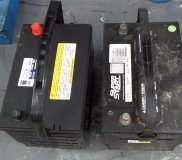Here's the deal. The regulator doesn't actually have an output as such. Current flows from the ASD relay to one of the brushes on the back of the alternator, through the rotating field winding, out the other brush, to the regulator in the Engine Computer, then to ground and back to the battery. A magnetic field is formed around the field winding. Three things are needed to generate the output voltage. Those are a coil of wire, magnet, and movement between the two. The field winding is the electromagnet. The movement comes from spinning it with the belt. The only practical way to control the output voltage is to strengthen or weaken the electromagnet. THAT is the purpose of the voltage regulator. At a maximum there will be around three amps of current flow through the field. Think of the regulator as nothing more than a variable resistance in series with the field winding. Under most common situations the regulator reduces field current to around one amp. A wire ties battery voltage to the regulator so it can measure system voltage. The regulator's resistance varies continuously so the alternator's output voltage stays between 13.75 and 14.75 volts. That means battery voltage during charging, alternator output voltage, and system voltage are all the same. That's the same voltage that you will find at light sockets and motors.
Monday, March 14th, 2011 AT 4:12 AM





